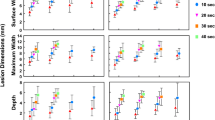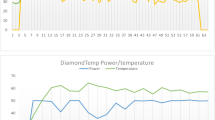Abstract
Background: Radiofrequency (RF) energy has been delivered to the tricuspid valve annulus (TVA) in humans with both 4 mm and 8 mm long catheter tip electrodes to treat atrial flutter. However, lesion volume with temperature controlled RF delivery systems has not been previously characterized.
Methods: In 10 anesthetized canines, a single pulse of temperature controlled RF energy at a 70°C set point, 30 second duration was delivered with either a 7 Fr/4 mm tip or a 7 Fr/8 mm tip electrode in a position both anterolateral and posteroseptal to the tricuspid valve annulus (TVA). Surface echocardiogram was obtained prior and after ablation. The animals were sacrificed after ablation and the lesions underwent gross and histological examination.
Results: Lesion size, tip temperature and power were related to tip electrode surface area (SA). Eight mm tips (SA = 59 mm2) tended to create significantly larger lesions than 4 mm tips (SA = 29 mm2). Median lesion volume was 22 vs. 1.5 mm3, respectively. Eight mm tips were also associated with higher power requirements and lower temperatures than 4 mm tips. Posteroseptal TVA lesions tended to be larger than anterolateral lesions. No significant complications were noted.
Conclusions: Using temperature controlled RF ablation, large lesions may be safely created on the canine TVA using 7 Fr catheters with 8 mm long tips.
Similar content being viewed by others
References
Nakagawa H, Lazzara R, Khastgir T, Beckman KJ, McClelland JH, Imai S, Pitha JV, Becker AE, Arruda M, Gonzalez, Widman LE, Rome M, Neuhauser J, Wang X, Calame JD, Goudeau MD, Jackman WM. Role of the tricuspid annulus and the eustachian valve/ridge on atrial flutter. Circulation 1996;94:407-424.
Langberg JJ, Gallagher M, Strickberger SA, et al. Temperature-guided radiofrequency catheter ablation with very large distal electrodes. Circulation 1993;88:245-249.
Hoyt RH, Huang SK, Marcus FI, et al. Factors influencing trans-catheter radiofrequency ablation of the myocardium. J Appl Cardiol 1986;1:469-486.
Blouin LT, Marcus FI. The effect of electrode design on the efficiency of delivery of radiofrequency energy to cardiac tissue in vitro. PACE 1989;12:136-143.
Jackman WM, Wang XZ, Friday KJ, et al. Catheter ablation of atrioventricular junction using radiofrequency current in 17 patients. Circulation 1991;83:1562-1576.
Chan R, Johnson S, Packer D. The effect of ablation electrode length and catheter tip-endocardial orientation on radiofrequency lesion size in the canine right atrium. PACE 1994;17(Abstract):797.
Author information
Authors and Affiliations
Rights and permissions
About this article
Cite this article
Mehdirad, A., Gaiser, J., Baker, P. et al. Effect of Catheter Tip Length and Position on Lesion Volume in Temperature Controlled RF Ablation in Canine Tricuspid Valve Annulus. J Interv Card Electrophysiol 2, 279–284 (1998). https://doi.org/10.1023/A:1009741105605
Issue Date:
DOI: https://doi.org/10.1023/A:1009741105605




